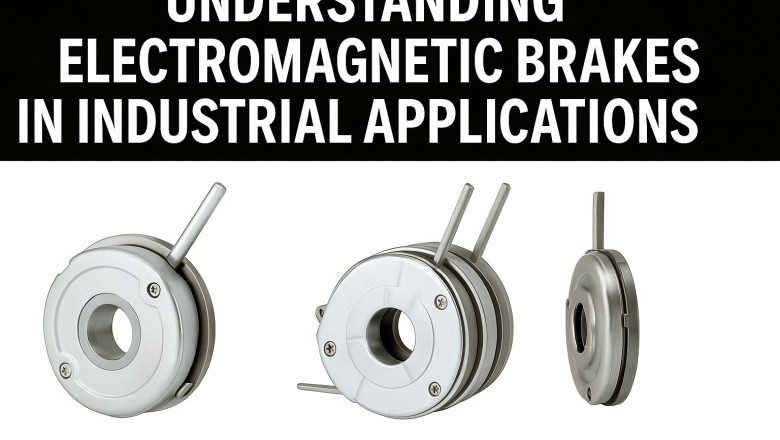views
How Electromagnetic Brakes Keep Machines Safe and Steady
Introduction
Have you ever thought about what brings massive industrial machines to a halt — and does it safely, quietly, and reliably? That’s the magic of Electro Magnetic Brakes. These advanced braking systems play a crucial role in manufacturing, automation, cranes, and robotics. While they might not get much attention, their role is absolutely vital.
In this guide, we’ll break down everything you need to know about DC Electromagnetic Brakes, why they're in high demand across industries, and how they’re making a difference in India’s industrial landscape.
1. What Are Electro Magnetic Brakes?
Electro Magnetic Brakes are braking systems that use electromagnetic force to stop or hold machinery. Unlike traditional mechanical brakes that rely on friction between parts, these brakes use electromagnetism to create resistance, reducing wear and improving reliability.
They’re especially popular in industrial settings where precision, speed, and durability matter.
2. How Do Electro Magnetic Brakes Work?
Think of it like this: when an electric current is applied to the coil inside the brake, it creates a magnetic field. This magnetic force pulls an armature plate toward a surface, applying pressure that creates braking force. Once the current is switched off, a spring mechanism pulls the plate away, releasing the brake.
This process happens almost instantly — which is crucial in high-speed or high-risk industrial environments. You can explore a detailed explanation of how this mechanism works in this informative blog post.
3. Components of an Electromagnetic DC Brake
Understanding the parts of the system can help in maintenance and troubleshooting. The main components include:
-
Electromagnet Coil – Generates the magnetic field.
-
Armature Plate – Pressed against the friction surface to stop movement.
-
Friction Disc – Offers resistance to the rotating part.
-
Spring – Disengages the brake when power is cut off.
-
Housing/Frame – Holds all components in place.
4. Types of DC Electromagnetic Brakes
There are several types of electromagnetic brakes tailored for specific needs:
-
Spring-Loaded Brakes – Common in lifts and cranes.
-
Fail-Safe Brakes – Engage automatically during power failure.
-
Holding Brakes – Maintain position of stationary parts.
Each type has its own advantage, depending on where and how it's used.
5. Key Features and Benefits
Why are industries switching to electromagnetic brakes?
-
Fast Response Time – Immediate braking action.
-
Minimal Wear and Tear – No physical contact like traditional brakes.
-
Low Maintenance – Fewer moving parts mean less breakdown.
-
Quiet Operation – No screeching or grinding sounds.
-
High Safety Standards – Especially in power-loss scenarios.
7. Why Industries Prefer Electromagnetic Brakes
Industries today demand efficiency, safety, and precision — all of which electromagnetic brakes deliver. Unlike hydraulic or pneumatic brakes, they don’t rely on fluid or air pressure, making them less prone to leaks or malfunctions.
Their energy-saving nature and compatibility with automated systems make them a smart investment for forward-thinking factories.
8. Factors to Consider When Choosing a Brake
Choosing the right brake depends on your machinery and its purpose. Key points include:
-
Load Capacity – Can it handle the operational load?
-
Speed Requirements – How fast does it need to stop?
-
Temperature Tolerance – Can it perform under heat?
-
Voltage Requirements – Match with your existing power setup.
-
Durability & Brand – Go with trusted names for long-term use.
9. Maintenance Tips for Long-Term Use
Like any system, a little care goes a long way. Here are quick tips:
-
Regular Inspection – Look for wear or residue buildup.
-
Check Wiring – Loose connections can affect braking.
-
Keep It Clean – Dust can affect performance.
-
Replace Components – Don’t wait for full failure.
-
Use OEM Parts – Always replace with original parts for the best fit.
10. Electromagnetic Braking System vs Traditional Brakes
Clearly, DC Electromagnetic Brakes are a modern, more efficient solution for industrial use.
Conclusion
Electro Magnetic Brakes are no longer optional — they’re essential for safe, efficient, and modern industrial machinery. Whether you’re upgrading your equipment or building new setups, integrating DC Electromagnetic Brakes could be your smartest move yet.
FAQs
1. What is the primary use of electromagnetic brakes in industry?
Electromagnetic brakes are used for precise stopping and holding in machines like conveyors, cranes, CNC systems, and automation setups.
2. How are DC Electromagnetic Brakes different from AC ones?
DC brakes usually offer more controlled and reliable braking for industrial applications, especially in emergency stop scenarios.
3. Are electromagnetic brakes energy-efficient?
Yes, they consume electricity only during activation and have lower wear and tear, making them energy-efficient in the long run.
4. Can electromagnetic brakes be used in high-temperature environments?
Yes, but it depends on the specific design and materials used. Always check manufacturer specifications.
5. Why are electromagnetic brakes popular in India?
With India’s focus on industrial automation and safety, electromagnetic brakes have become an essential component of modern industrial brake systems.













Comments
0 comment